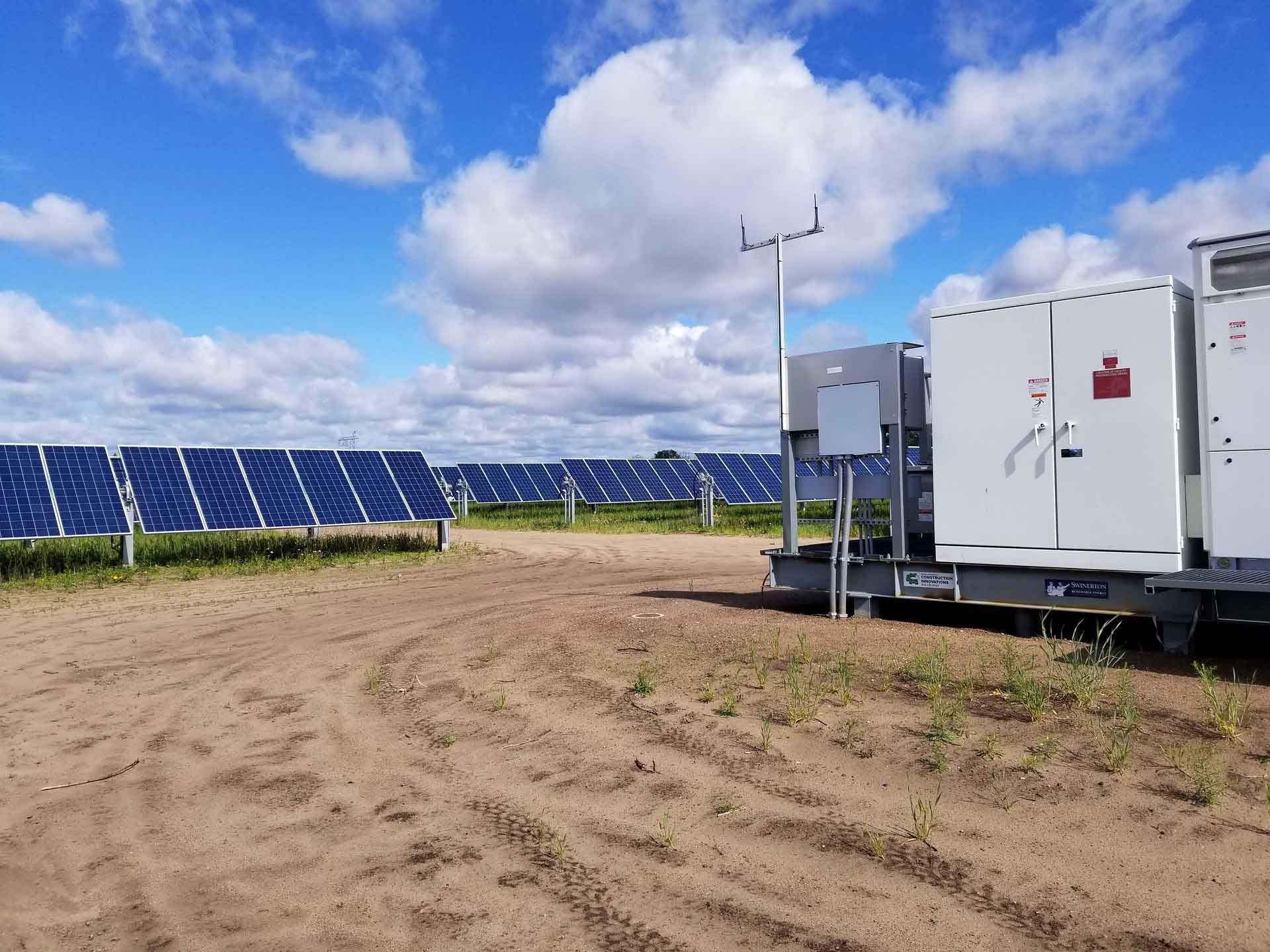Chapter 1: Innovations in Solar Battery Storage Technology

Solar battery storage technology has seen significant advancements in recent years, driven by the growing demand for renewable energy solutions and the need for efficient energy storage. Some key innovations include:
- Increased Energy Density: Modern solar batteries are being designed to store more energy in a smaller space. This is crucial for making solar battery storage more practical and accessible, especially in urban areas where space is limited.
- Improved Lifespan and Durability: Advances in materials and design have led to solar batteries with longer lifespans and greater durability. This reduces the need for frequent replacements and lowers the long-term cost of solar battery storage.
- Lithium-Ion Batteries: These have become more popular in solar battery storage due to their high energy density and decreasing cost. Their efficiency and charging speed have also improved.
- Solid-State Batteries: A newer development, solid-state batteries, replace the liquid electrolyte with a solid. This can potentially offer greater energy density, safety, and longer life compared to traditional lithium-ion batteries.
- Flow Batteries: These are gaining attention for their ability to store large amounts of energy, making them ideal for grid-scale storage. They offer longer cycle life and can be easily scaled.
- Smart Battery Management Systems: Modern solar batteries are often equipped with smart technology that optimizes charging and discharging, improving overall efficiency and lifespan.
- Integration with Smart Grids: Solar batteries are increasingly being integrated into smart grid systems, which allows for better energy management and distribution based on demand and supply.
- Cost Reductions: Continuous research and development in solar battery technology have led to significant cost reductions, making solar battery storage more accessible and affordable.
- Eco-Friendly Materials: There’s a growing focus on using more sustainable and less toxic materials in battery production, reducing the environmental impact of solar battery storage systems.
- Recycling and Repurposing: Efforts are being made to develop effective recycling processes for solar batteries to ensure that materials are reused and waste is minimized.
These innovations not only enhance the efficiency and feasibility of solar battery storage but also contribute to a more sustainable and environmentally friendly energy landscape.
Chapter 2: Exploring the Efficiency of Solar Battery Storage in Residential Home
The efficiency of solar battery storage in residential homes is a crucial aspect to consider when investing in solar energy systems. This efficiency is influenced by several key factors:
- Battery Technology: Different types of batteries, like lithium-ion or lead-acid, have varying efficiencies and life spans. Lithium-ion batteries are generally more efficient and have a longer life cycle.
- System Design: The way the solar panels and batteries are integrated plays a significant role. Optimally designed systems minimize energy loss during conversion and distribution.
- Energy Management: Smart energy management systems can significantly improve efficiency by optimizing when to store and use solar battery storage, depending on the household’s energy consumption patterns and the availability of sunlight.
- Temperature and Environmental Conditions: Battery performance can be affected by temperature extremes. Proper installation and insulation can help mitigate these effects.
- Capacity and Depth of Discharge (DoD): The capacity of a battery and how much of that capacity can be used without affecting its lifespan (DoD) are important. A higher DoD typically means better utilization of the battery’s capacity.
- Maintenance and Aging: Over time, batteries degrade and lose efficiency. Regular maintenance and timely replacement are important for maintaining system efficiency.
- Solar Panel Efficiency: The efficiency of the solar panels themselves also plays a role, as more efficient panels can generate more electricity in the same amount of space and light conditions.
The benefits of solar battery storage in a residential setting include energy independence, reduced electricity bills, and a lower carbon footprint. However, the initial investment can be significant, and it’s important to consider factors like local solar irradiance, electricity tariffs, and available incentives or rebates.
Advancements in technology continue to improve the efficiency and cost-effectiveness of solar battery storage, making them an increasingly viable option for residential energy needs.
Chapter 3: The Impact of Solar Battery Storage on Reducing Carbon Footprint

The impact of solar battery storage on reducing carbon footprint is significant and multi-faceted. Here’s how it contributes:
- Increased Use of Renewable Energy: Solar battery storage systems enable the storage of solar energy, making it available even when the sun isn’t shining. This allows for a higher utilization of solar battery storage, a clean and renewable source, thus reducing reliance on fossil fuels.
- Reduction in Greenhouse Gas Emissions: By maximizing the use of solar battery storage, these systems reduce the need for electricity generation from fossil fuel-powered plants, which are major contributors to greenhouse gas emissions. This directly aids in lowering the carbon footprint associated with energy production.
- Grid Stabilization and Efficiency: Solar batteries help in stabilizing the electricity grid by providing energy during peak demand times, which can reduce the need for additional fossil fuel-powered energy production. Moreover, by storing excess solar battery storage, these systems improve the overall efficiency of the energy use.
- Enabling Off-Grid Solutions: In remote locations, solar battery storage can provide a viable alternative to diesel generators, which are carbon-intensive. This is particularly beneficial in rural or isolated areas, contributing to a decrease in overall carbon emissions.
- Supporting Decentralized Energy Systems: Solar battery storage enables the creation of decentralized energy systems, where energy is produced and consumed locally. This reduces energy loss that occurs during transmission over long distances, further decreasing the carbon footprint.
- Encouraging Energy Conservation: The presence of a solar battery storage can encourage consumers to be more conscious of their energy consumption patterns, promoting energy conservation and efficiency.
- Lifecycle Emissions: While manufacturing and disposal of batteries do have an environmental impact, advancements in recycling technologies and more sustainable production practices are aimed at minimizing these effects. The net result is still a reduction in carbon footprint compared to traditional energy sources.
- Complementary to Other Renewable Sources: Solar battery storage can be integrated with other renewable energy sources like wind, further enhancing the ability to reduce reliance on fossil fuels.
Overall, the integration of solar battery storage into energy systems presents a powerful tool in the fight against climate change, offering a sustainable, efficient, and increasingly cost-effective way to reduce global carbon emissions.
Chapter 4: Integrating Solar Battery Storage into the Modern Power Grid
Integrating solar battery storage into the modern power grid is an increasingly important topic as the world shifts towards renewable energy sources. The integration process involves several key aspects:
- Energy Storage Technology: Solar battery storage typically uses lithium-ion batteries or other advanced battery technologies. These batteries store energy generated by solar panels during peak sunlight hours and release it when needed, especially during periods of low solar generation or high energy demand.
- Grid Stability and Reliability: Integrating battery storage helps stabilize the power grid. Solar battery storage is intermittent, and without storage, this can lead to instability in the power grid. Batteries provide a buffer, absorbing excess energy and releasing it when solar generation is low, thus maintaining a steady flow of electricity.
- Smart Grid Technology: Modern power grids are increasingly turning into smart grids, equipped with advanced metering, sensors, and IoT technologies. These tools help in efficiently managing energy flow, including the energy stored in and released from solar battery storage. They also help in predicting energy demand and adjusting the supply accordingly.
- Regulatory Frameworks and Incentives: Governments and regulatory bodies play a crucial role. They need to create policies and incentives that encourage the adoption of solar battery storage, such as subsidies, tax rebates, or feed-in tariffs for excess energy fed back into the grid.
- Economic Viability: The cost of battery storage is a critical factor. As technology advances and production scales up, costs are expected to decrease, making it more economically viable for wider adoption.
- Decentralization of Power Generation: With solar battery storage, consumers can become prosumers (producer-consumers), generating their own electricity and contributing to the grid’s stability. This decentralization requires a different approach to grid management, emphasizing local energy balances.
- Scalability and Flexibility: The power grid must be flexible enough to integrate storage solutions of varying sizes, from small residential systems to large utility-scale storage.
- Environmental Considerations: While solar battery storage is clean, the production and disposal of batteries pose environmental challenges. It’s important to develop environmentally friendly battery technologies and recycling methods.
In conclusion, integrating solar battery storage into the modern power grid is a multi-faceted process that involves technological innovation, regulatory support, economic considerations, and a shift towards smarter and more decentralized power systems. As technology evolves and costs decrease, solar battery storage is expected to become an increasingly vital part of our electricity infrastructure, aiding in the transition to renewable energy.
Chapter 5: Cost-Benefit Analysis of Solar Battery Storage for Businesses

A cost-benefit analysis of solar battery storage for businesses involves evaluating several key factors:
- Initial Investment: The upfront cost includes purchasing solar battery storage, battery storage systems, installation, and any necessary modifications to the infrastructure.
- Energy Savings: Determine how much energy the system will produce and how this offsets your current energy costs. This varies depending on your location, the size of the installation, and your current energy usage.
- Battery Lifespan and Efficiency: Solar battery storage degrade over time. Consider the lifespan of the storage system and how efficiently it can store and release energy.
- Maintenance and Operational Costs: Regular maintenance is required to keep the system functioning optimally. There might also be additional operational costs.
- Government Incentives and Rebates: Many governments offer incentives for renewable energy investments, which can significantly reduce the overall cost.
- Energy Independence and Security: By generating your own power, your business can reduce its dependence on the grid, which can be particularly beneficial in areas with unreliable power supplies or high energy costs.
- Environmental Impact: Utilizing renewable energy reduces your carbon footprint and can enhance your business’s public image.
- Return on Investment (ROI): Calculate how long it will take for the energy savings to cover the initial investment. This will depend on factors like energy production, energy savings, and system lifespan.
- Resale Value and Business Image: Implementing renewable energy solutions can increase the value of your property and positively affect your brand as a sustainable business.
- Market Trends and Energy Prices: Future trends in energy costs and the evolving state of renewable technology can impact the long-term benefits and savings.
- Regulatory Environment: Consider potential changes in regulations related to energy, which might affect future costs or benefits.
For a detailed and personalized analysis, it’s advisable to consult with an expert in solar battery storage who can analyze your specific situation, considering all relevant local factors and providing a detailed financial model.
Chapter 6: Overcoming Challenges in Solar Battery Storage Deployment
Deploying solar battery storage effectively faces several challenges, but there are also numerous strategies to overcome these hurdles. Here are some common challenges and potential solutions:
- High Costs: Initial costs for solar battery storage systems can be high. However, this can be mitigated through financial incentives like tax credits, rebates, and subsidies. Economies of scale and advancements in technology are also driving down costs over time.
- Technology Limitations: Current battery technologies have limitations in terms of energy density, lifespan, and efficiency. Ongoing research and development are crucial here. Investing in emerging technologies like solid-state batteries or flow batteries can offer better performance and longer lifespans.
- Regulatory Hurdles: Inconsistent or unfavorable regulatory policies can impede the deployment of solar battery storage. Advocacy for better policies, public-private partnerships, and community-based initiatives can help in overcoming these barriers.
- Grid Integration: Integrating solar battery storage with existing power grids can be complex. Smart grid technologies and advanced grid management systems can enable smoother integration. Also, policies encouraging grid-tied solar battery storage can make this process more streamlined.
- Environmental Concerns: The production and disposal of batteries raise environmental concerns. Recycling programs for batteries, as well as research into more sustainable materials and manufacturing processes, are important in this regard.
- Market Uncertainty: The solar battery storage market can be volatile, influenced by global supply chains and fluctuating material costs. Diversifying supply chains and investing in local production can mitigate some of these risks.
- Energy Density and Storage Capacity: Batteries need to store more energy for longer durations to be truly effective for large-scale renewable integration. Advances in battery chemistry and design, such as lithium-ion technology or alternative storage solutions like hydrogen storage, can address these needs.
- Education and Awareness: There’s often a lack of awareness about the benefits and feasibility of solar battery storage. Educational campaigns and demonstrations of successful projects can increase awareness and adoption.
- Technical Expertise: Installing and maintaining solar battery storage requires technical expertise. Investing in training programs and certifications for professionals can ensure a skilled workforce for these technologies.
- Safety Concerns: Batteries, especially lithium-ion, can pose safety risks like fires. Stricter safety standards, better design, and advanced materials can reduce these risks.
By addressing these challenges through a combination of technological innovation, policy changes, financial mechanisms, and educational efforts, the deployment of solar battery storage can be significantly enhanced, contributing to a more sustainable and resilient energy future.
Chapter 7: The Role of Solar Battery Storage in Disaster Resilience and Emergency Power Supply
Solar battery storage plays a crucial role in disaster resilience and emergency power supply in several ways:
- Ensuring Continuous Power Supply: In the event of disasters like hurricanes, earthquakes, or floods, traditional power grids often fail. Solar battery storage systems can provide an uninterrupted power supply, ensuring that essential services such as hospitals, communication systems, and emergency lighting remain operational.
- Reduced Dependency on Grid: Solar battery storage reduce reliance on the main power grid. This is particularly valuable in disasters when the grid is damaged or unavailable. Homes and facilities with solar battery storage can still have power even when the grid is down.
- Portability and Flexibility: Some solar battery storage are portable, allowing them to be used in different locations as needed, which is especially useful in emergency response situations. They can be deployed quickly to areas that need power most.
- Support for Critical Infrastructure: Solar battery storage can be essential for keeping critical infrastructure running during disasters, such as water purification systems, emergency shelters, and communication networks.
- Eco-Friendly and Sustainable: Unlike diesel generators, solar battery storage do not produce greenhouse gases or noise pollution. This makes them an environmentally friendly option for emergency power.
- Energy Independence and Security: In disaster-prone areas, having solar battery storage can provide a sense of security and independence, as residents are not solely dependent on the stability of the external power grid.
- Scalability: Solar battery storage systems can be scaled to meet different needs – from small residential systems to larger community or industrial-scale systems.
- Grid Stabilization Post-Disaster: When the main grid is back online after a disaster, solar battery storage can help stabilize it by providing energy storage and load balancing.
- Cost-Effectiveness Over Time: Although the initial investment can be significant, solar battery storage can be more cost-effective in the long run, especially in areas frequently affected by power outages due to disasters.
In summary, solar battery storage is an essential component of a resilient and sustainable approach to disaster preparedness and emergency power supply, offering reliable, flexible, and eco-friendly power solutions.
Chapter 8: Evaluating the Lifespan and Performance of Solar Battery Storage Systems

Evaluating the lifespan and performance of solar battery storage systems is crucial for understanding their efficiency and value over time. Here are key factors to consider:
- Battery Type: Different types of batteries, like lead-acid, lithium-ion, and saltwater, have varying lifespans and performance characteristics. Lithium-ion batteries are currently the most common in solar battery storage systems applications due to their high energy density and longer lifespan.
- Depth of Discharge (DoD): This refers to how much of the battery’s capacity is used. A battery that is regularly deeply discharged (using a high percentage of its capacity) will generally have a shorter lifespan than one that is lightly discharged.
- Cycle Life: This is the number of charge and discharge cycles a battery can undergo before its capacity falls below a certain percentage of its original capacity. For instance, a lithium-ion battery might retain 80% of its original capacity after 5000 cycles.
- Temperature and Environmental Conditions: Extremes of heat or cold can negatively impact battery life. Systems should be installed in a location where temperatures are stable, and protective measures should be in place for extreme conditions.
- Maintenance: Regular maintenance can extend the life of some battery types. Lead-acid batteries, for instance, require more maintenance compared to lithium-ion batteries.
- Capacity and Efficiency Over Time: As batteries age, their capacity to hold a charge diminishes. Efficiency also tends to decrease, meaning they can store and deliver less energy compared to their initial state.
- Warranty and Manufacturer Claims: Manufacturers typically offer warranties that guarantee a certain battery capacity (like 80%) over a specified number of years or cycles. These warranties are a good indicator of the manufacturer’s confidence in their product’s lifespan.
- System Integration and Management: How the battery is integrated into the solar battery storage systems, including the use of charge controllers and battery management systems, can impact its effective lifespan and performance.
- Cost-Benefit Analysis: Evaluating the initial cost versus the expected lifespan and performance can provide insight into the overall value of the solar battery storage systems.
- Technology Advances: Battery technology is continually advancing, with newer models offering better lifespan and performance. It’s important to consider the latest technologies when making a decision.
Regular monitoring and performance analysis can help in understanding how well the solar battery storage systems are functioning over time and when it might need replacement or maintenance.
Chapter 9: Comparative Study of Solar Battery Storage Technologies Across Different Climates
Conducting a comparative study of solar battery storage technologies across different climates involves considering several key factors:
- Battery Types: Different battery technologies, like lead-acid, lithium-ion, and flow batteries, have varying performance characteristics. Lithium-ion batteries are popular due to their high energy density and long lifespan, while lead-acid batteries are more cost-effective but have a shorter lifespan and lower energy density. Flow batteries might offer benefits in scalability and longevity.
- Climate Impact: The performance and lifespan of solar battery storage can be significantly influenced by the climate. For example:
- Hot Climates: High temperatures can accelerate the degradation of batteries, especially for lithium-ion types. Thermal management systems are crucial in these environments.
- Cold Climates: Batteries can suffer from reduced capacity and slower chemical reactions at low temperatures. Systems that can operate effectively in cold climates often require additional insulation or heating elements.
- Efficiency: The efficiency of a solar battery storage is how effectively it can store and release energy. This can be impacted by temperature, with extreme conditions often leading to reduced efficiency.
- Cost: The cost-effectiveness of solar battery storage systems can vary depending on the climate due to the need for additional protective measures or climate control systems.
- Durability and Maintenance: Maintenance needs can vary significantly depending on the climate. For example, batteries in humid or salty air environments might require more robust casing to prevent corrosion.
- Energy Storage Capacity: The capacity required might differ based on sunlight availability in different climates. Regions with less consistent sunlight might require larger storage capacity to ensure a steady power supply.
- Integration with Renewable Energy Sources: The integration with other renewable sources like wind or hydro might be more relevant in certain climates, affecting the choice and utilization of solar battery storage systems.
- Regulatory and Market Factors: Different regions might have varying regulations and incentives for renewable energy storage, impacting the feasibility and design of solar battery storage systems.
- Technological Advancements: The development of new battery technologies, like solid-state batteries, could change the landscape of solar battery storage, offering better performance in various climates.
To get a comprehensive understanding, it would be ideal to look at case studies or research conducted in different climate zones, analyzing the performance and longevity of various solar battery storage systems under distinct environmental conditions.
